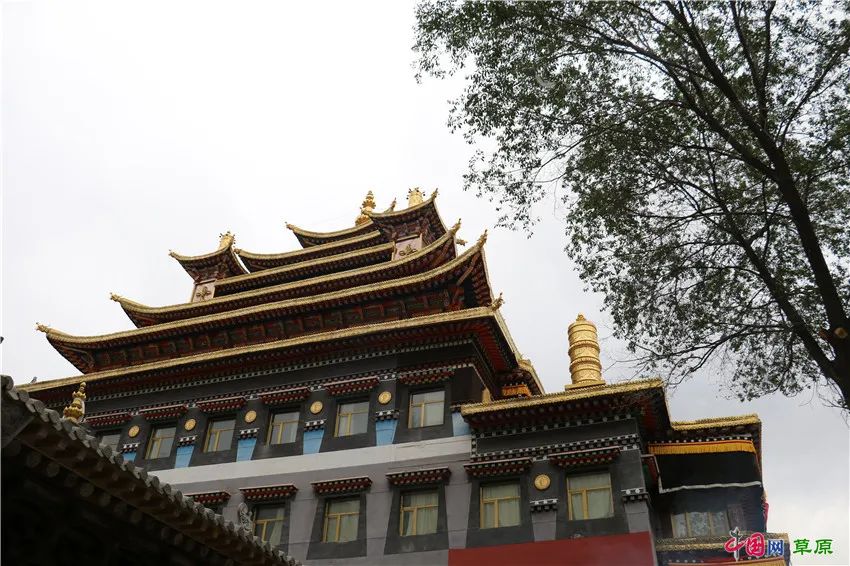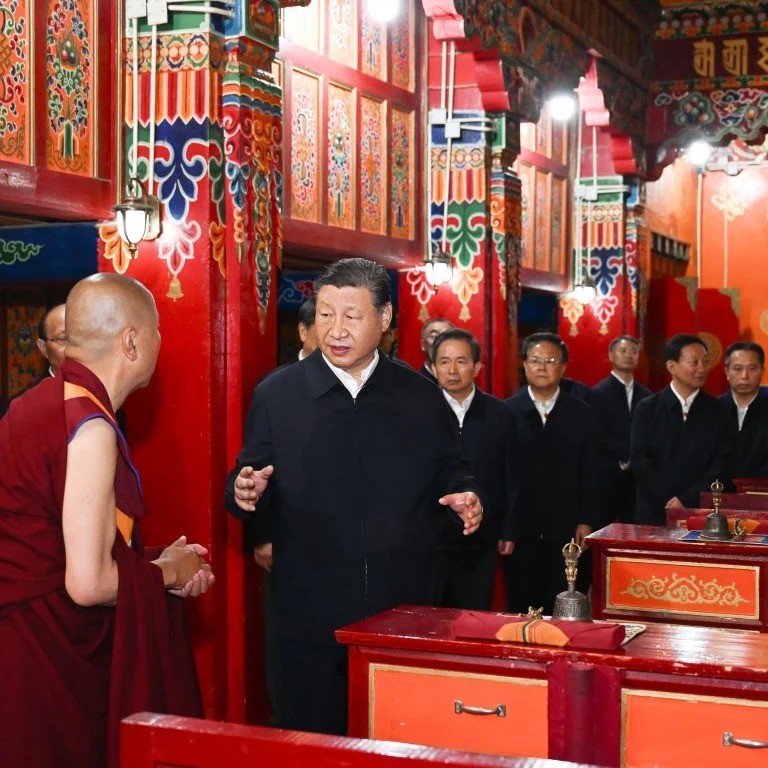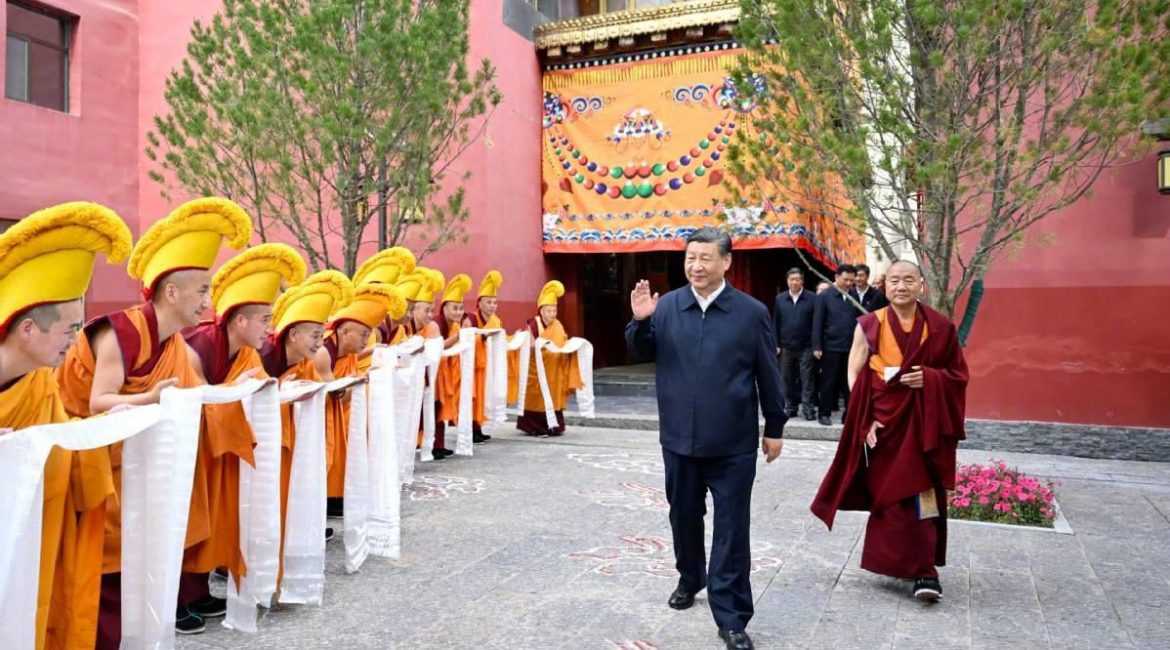During an inspection of Qinghai from 18–19 June, Chinese president Xi Jinping visited the Gelug Hongjue Temple (known in full as Tsongkha Daci Hongjue Temple 宗喀大慈宏覺寺) in Xining on the 18th. Chinese media emphasized the significance of how this sacred site could foster both unity and environmental stewardship. During the visit, Mr. Xi highlighted Qinghai’s mission to preserve ecological security, noting that a healthy economy would follow: Qinghai province is rich in petroleum, natural gas, and industry-critical mineral resources, including potassium and lithium. The visit underscored the potential contributions that the monastery could make to the fragile Tibetan plateau’s ecological conservation.
This visit came on the heels of the passing of the “Promoting a Resolution to the Tibet-China Dispute Act” by the US House of Representatives this month (an update on an earlier 2002 act), and former House speaker Nancy Pelosi’s visit to the Dalai Lama in Dharamshala with a bipartisan group of American politicians. There are deliberate optics that the American government is aiming for. By and large, those optics are intended for Gelug allies, aiming to project the Dalai Lama as the sole voice of Tibetan Buddhism (or at least the only voice worth listening to from the US perspective).

Mr. Xi’s visits to Buddhist temples are rare and deliberate enough to attract commentary and analyses about their meaning, sometimes for the Chinese leader personally (like with Linji Temple in Zhejiang). In this case, his choice of Hongjue Temple is replete with historical echoes and symbols of Sino-Tibetan integration in the Qinghai-Tibet region. The original location was founded in 941, according to senior resident monk Konchok Gyatso, by a master who had been taught and approved by three masters from Tibetan Buddhism and two from Chinese Buddhism. “And Hongjue is the temple with the longest history for integrating the cultures of both Tibetan Buddhism and Chinese Buddhism in China.” (China Daily) It eventually became associated with Gelug founder Tsongkhapa, likely due to his prolific activities in the Qinghai region. Several other temples also bear his historical presence.
Hongjue Temple’s reputation as a “bridge of communications” between Chinese central governments and Tibetan rulers comes from three key events, all of them imbued with undertones of patriotism and Chinese territorial integrity. In 1779, the 6th Panchen Lama, Lobsang Palden Yeshe, was invited to Beijing by Emperor Qianlong of the Qing Dynasty (1644–1911). The emperor renovated Hongjue Temple to welcome him, and the monastery hence became the Panchen Lama lineage’s key temporary residents or pit stops in Qinghai. (Xinhua Daily Telegraph) The second instance dates to the Great Patriotic War or the Second Sino-Japanese War, when the 9th Panchen Lama donated 36 aircraft and 300,000 silver dollars to the anti-Japanese war effort. (Xinhua Daily Telegraph)
It is little known that as early as the Republican period in China, the 9th Panchen Lama fled to Inner Mongolia. He left Tibet in 1923 and settled in the Republic of China in 1925. Over disputes in taxation, his own monastery’s monks had been locked up by the Gelug government, with his officials imprisoned in Lhasa. This power struggle within a single school (the Gelug) inside Tibet, coming at great cost to domestic development (or the lack thereof) and regional instability, was a foretaste of the unsustainable situation that would ultimately require a re-establishment of past norms, including Chinese sovereignty.

More critically, Hongjue Temple was the place from which the 10th Panchen Lama (Lobsang Trinley Lhündrub Chökyi Gyaltsen) set off from Hongjue Temple in April 1951 and went to Beijing with official Ngapoi Ngawang Jigme (1993–2009) to participate in the signing ceremony of the Seventeen-Article Agreement concerning Tibet, which was ratified on 23 May of that year. The Seventeen-Article Agreement was repudiated by the Dalai Lama in 1960, after the 1959 uprising. The legacy of that treaty, and the memory of a feudal Tibet ruled over by an isolated and antiquated Gelug establishment, was most likely part of the considerations that Mr. Xi carefully deliberated over before choosing to visit the monastery.
Mr. Xi’s visit to Hongjue Temple is effectively a response to the US and Gelug allies, noting that the region is under Chinese authority and that there was an agreement that would have shown the way to peace, but which the Dalai Lama repudiated. It will underscore to the US the reality that the Gelug leadership steering the Tibetan government-in-exile currently has no route to genuine dialogue with the Chinese government. Effectively, this visit is stating that the telegraphing of American displeasure or geopolitical mischief is a waste of time.
Finally, and perhaps most significantly in regard to future events, Mr. Xi felt it worth reminding the US that since Hongjue Temple is a Gelug institution, there are Gelug forces from this monastery and in other prominent Gelug (and non-Gelug) institutions in Tibet and Tibetan regions that are willing to put Tibetan welfare and national unity as a priority more than the wish of the Gelugpas in exile and their US allies’ priority of reviving the pre-1959, Mongolian-imposed arrangement of the 14th Dalai Lama in the Potala Palace.
See more
Xi calls for carrying forward patriotism (China Daily)
巍巍高原古寺 濃濃中華情融 (Chinese only) (Xinhua Daily Telegraph)


